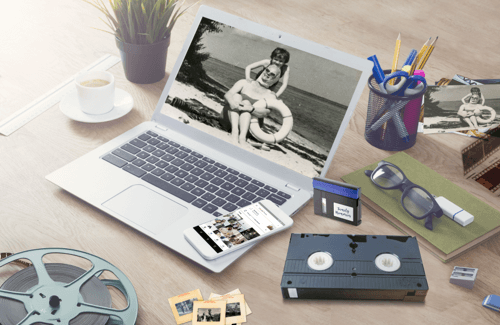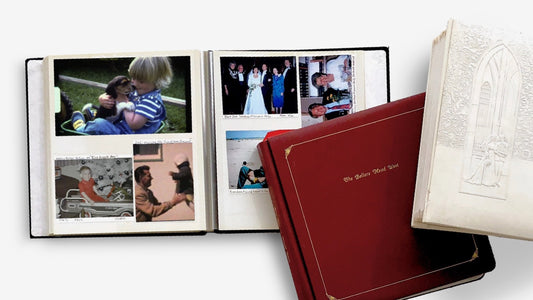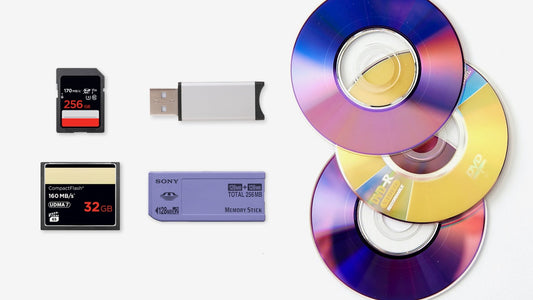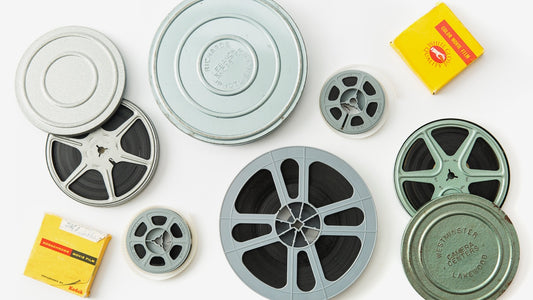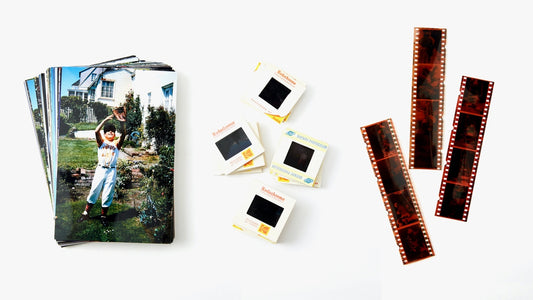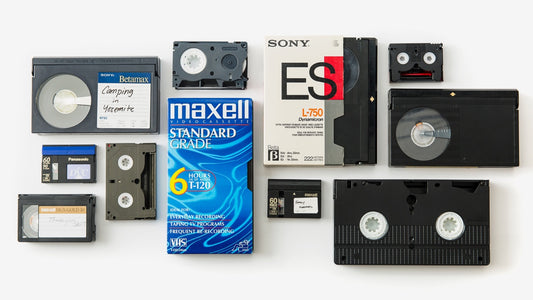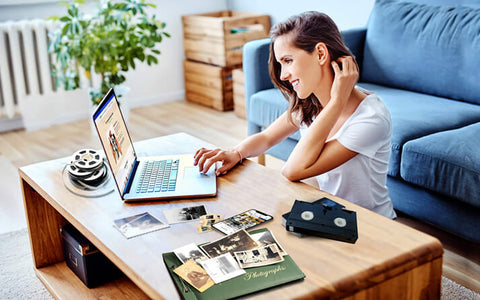Let’s be honest: those VHS tapes holding your family's history weren't built to last. The magnetic tape inside is slowly fading, and with it, the sound of your dad's laugh or the sight of your first steps. Worse, they’re at risk from heat, moisture, or an old VCR that could ruin them forever. To protect these irreplaceable moments, you need to digitize VHS tapes. This guide will walk you through your options, from local services you might find when searching for “digitize VHS tapes near me” to specialized companies that handle your memories with expert care.
Key Takeaways
- Rescue Your Memories Before They Fade: VHS tapes naturally degrade over time, causing video and audio quality to decline. Digitizing is the only way to permanently stop this decay and protect your family’s history from being lost to age or accidents.
- Prioritize Expertise Over Simple Convenience: While local drop-off services seem easy, a specialized company offers professional equipment and hands-on care. For irreplaceable memories, choosing a trusted expert ensures the highest quality result and peace of mind.
- Know What to Expect for a Smooth Process: Prepare for your project by gathering and labeling your tapes. Decide whether you want your digital files on a USB, DVD, or in the cloud, and plan for a standard turnaround time of about three to four weeks for a careful, professional transfer.
Why It's Time to Digitize Your VHS Tapes
That box of VHS tapes sitting in your attic or closet is a treasure chest of memories. It holds first steps, birthday parties, and holiday gatherings you can’t get back. But those memories are trapped on a format that’s slowly fading away. Digitizing your tapes isn't just a technical upgrade; it's about safeguarding your family’s history for future generations to enjoy.
Making the switch from analog to digital breathes new life into your home movies. It makes them accessible, shareable, and safe from the wear and tear of time. If you’ve been putting it off, think about the incredible value locked away in those tapes. By converting them, you’re not just preserving old videos—you’re ensuring your most cherished moments can be relived and celebrated for years to come. It’s a simple step that protects your legacy and keeps your family’s story alive and well.
Preserve Your Memories Before They Fade
VHS tapes simply aren't made to last forever. The magnetic tape inside them degrades over time, even when stored carefully. With each passing year, the video quality can worsen, leading to color loss, distorted sound, and fuzzy images. This natural decay means your precious memories are literally fading away. Think of digitization as a rescue mission for your family’s history. A professional video transfer service can capture the content from your tapes before any more quality is lost, preserving those moments exactly as you remember them. It’s a worthwhile investment to stop the slow erase of time and keep your memories vibrant.
Share Your Favorite Moments, Instantly
Remember the last time you tried to watch a home movie? You had to dig out the VCR, untangle a mess of cables, and hope the machine didn’t eat the tape. Once your memories are digitized, sharing them becomes effortless. You can send a clip of your parents’ wedding to the entire family in a group chat, post a throwback video of your kid’s first steps on social media, or stream the annual family vacation on your smart TV. YesVideo has helped countless families protect and share generations of memories, connecting loved ones near and far. Digitization removes the barriers, allowing your favorite moments to be enjoyed anytime, anywhere, by anyone you choose.
Protect Your Tapes from Damage and Decay
Beyond the natural aging process, VHS tapes are vulnerable to physical damage. A leaky pipe in the basement, a hot attic, or a simple accident can ruin them in an instant. Mold, heat, and moisture are the enemies of magnetic tape, causing irreversible harm. Even a faulty VCR can chew up a tape, destroying a one-of-a-kind memory forever. Converting your tapes to a digital format is the ultimate insurance policy. By creating a digital backup, you ensure your family’s story is safe from floods, fires, and decay. A trusted service will handle your originals with care and provide a high-quality digital copy, allowing you to protect your legacy for good.
Where Can You Digitize VHS Tapes?
Once you’ve gathered your tapes, the next step is finding the right service to handle your precious memories. You have quite a few options, each with its own benefits, so you can choose the one that best fits your needs for convenience, expertise, and budget. From dedicated online specialists who handle everything by mail to the familiar photo counter at your local big-box store, there’s a reliable choice for every family. Let’s walk through some of the most popular and trusted places to get your VHS tapes converted.
YesVideo
If you’re looking for a service that specializes in preserving memories, YesVideo is a top contender. With over 20 years of experience, they have helped millions of families protect their home movies. They are the largest video transfer service in the world, and every order is processed by hand by a team of trained technicians in the USA. Because this is their sole focus, you can trust that your tapes are in expert hands. They handle everything from VHS and film reels to photo albums, making them a one-stop shop for all your digitization projects.
A Trusted Service for Over 20 Years
When you’re handing over irreplaceable memories, experience matters. YesVideo has been a leader in the video transfer industry for over 20 years, helping millions of families protect their home movies. That long history isn’t just a number—it’s a track record built on understanding the nuances of preserving precious moments. Their team has seen every kind of tape format and condition imaginable, so they know exactly how to handle your aging media with care. This deep expertise ensures they can manage the entire process professionally, making them a reliable choice for digitizing your most important memories.
Hand-Processed in the USA
What really sets a specialized service apart is the human touch. Every order at YesVideo is processed by hand by a team of trained technicians right here in the USA. This hands-on approach means your tapes aren’t just fed into a machine and forgotten. A real person inspects your media, monitors the transfer, and ensures the final digital files maintain the integrity of your original recordings. This level of care is applied to every format they handle, whether it's a box of VHS tapes or delicate photo albums. It’s a commitment to quality that provides peace of mind, knowing your memories are being treated with respect.
CVS Photo
For many, convenience is key. CVS Photo offers a simple way to digitize your memories while you’re out running errands. You can drop off your old media at their photo counter and have them converted to digital copies, a DVD, or a USB drive. Their home movie transfer service is a great option if you prefer handling the process in person at a location you already know and trust. It’s a straightforward way to ensure your favorite moments are preserved and ready to be shared with family and friends.
Pricing and Turnaround Time
When you drop your tapes off at CVS, you can expect your finished order to be ready in about three weeks. This is a relatively quick turnaround, especially when compared to some mail-in services that can take anywhere from four to twelve weeks to process an order. This speed makes it a great option if you need your memories digitized for an upcoming event, like a family reunion or a milestone birthday. While you'll get a specific quote in the store, pricing is competitive. For context, similar services at places like Walgreens often start around $34.99 per tape, giving you a ballpark idea of the investment.
Accepted Formats and Output Options
CVS gives you plenty of flexibility in how you get your memories back. You can have your videos saved on DVDs, a USB drive, or even a Blu-ray disc. They also provide a digital copy you can download, which is perfect for saving directly to your computer or sharing with family online. Like many retail transfer services, they can handle a wide range of formats beyond just standard VHS, including VHS-C, Betamax, Hi8, and MiniDV. This means you can likely get your entire collection of tapes converted in one place, whether you want a physical copy for safekeeping or a digital file for easy access.
Walgreens Photo
Similar to CVS, Walgreens provides a convenient in-store service for digitizing your old media. You can bring in a variety of formats, including VHS tapes and old film reels, and they will convert them into modern digital files on a DVD or USB. This service is designed to make memory preservation accessible and easy. Dropping your tapes off at a local Walgreens Photo center means you can get the process started without having to worry about packaging and shipping them yourself.
Pricing and Turnaround Time
Figuring out the cost and timeline is a key step in any project, and digitizing your memories is no different. Services vary quite a bit, with some offering quick, local drop-offs and others providing specialized, hands-on care that might take a little longer. Understanding these differences helps you choose a service that fits your budget and schedule, so you know exactly what to expect. Whether you need your tapes back for a specific event or you’re just ready to get it done, comparing these options will help you find the perfect fit for your family’s precious home movies.
Here’s a look at what some of the most popular services offer:
- YesVideo: Because we specialize in this work, we’ve found a sweet spot between speed and quality. Our standard process takes about 3–4 weeks once we receive your order. This gives our US-based technicians enough time to carefully handle every tape by hand, ensuring a high-quality transfer. Our pricing is straightforward and based on the type and length of your media, so there are no surprises.
- Legacybox: This service uses a kit-based model where you fill a pre-paid box with a specific number of items, from two to forty. It’s a good option for large collections. Their standard turnaround time is about 10–12 weeks, so you’ll want to plan for a longer wait while they process your memories.
- CVS Photo: If you value convenience and want to handle things in person, CVS is a solid choice. You can drop your tapes off at a local store, and their home movie transfer service typically takes about 3 weeks. It’s a quick and simple way to get your project started without dealing with shipping.
- Walgreens Photo: Much like CVS, Walgreens offers an easy in-store drop-off service. With a similar turnaround time of about 3 weeks, it’s another great local option for digitizing your VHS tapes. This is ideal if you have a Walgreens nearby and prefer a straightforward, hassle-free process.
Walmart Photo
Walmart also offers a comprehensive video transfer service that can digitize a wide array of media, from videotapes and film to photos, slides, and negatives. This is an excellent choice if you have a mix of different formats you want to preserve. By converting them to a modern digital format, you protect them from the risk of decay and make them incredibly easy to share. The accessibility of Walmart makes it a practical option for many families looking to safeguard their memories for future generations.
Costco Photo Center
If you’re a Costco member, their photo center is another reliable place to consider. They provide a service for converting VHS tapes to digital formats, ensuring your memories are safe, modern, and easy to access. This service is ideal for anyone looking to protect their old media from degradation while making it simple to view and share. It’s a trusted option that integrates smoothly into a shopping trip, combining convenience with the quality you expect from Costco.
Other National Services (Kodak, Legacybox)
Beyond the big-box stores, you’ll find national mail-in services that specialize in digitization. Two of the most well-known are Kodak and Legacybox. Both are popular choices for families looking to preserve their memories, but they offer different experiences when it comes to pricing, turnaround time, and the overall process. Understanding these differences can help you decide which service aligns best with your expectations and the scope of your project. Each has its own unique approach, from all-inclusive kits to a la carte pricing, so it’s worth looking at the details before you ship your precious tapes.
Pricing Models: Per-Item vs. Kits
The way you pay for digitization can vary significantly between services. Legacybox is known for its kit-based model, where you purchase an all-in-one kit designed to hold a specific number of items—for example, a 10-item box or a 20-item box. This is great if you have a set number of tapes and want a single, upfront price. In contrast, Kodak Digitizing offers a more flexible pricing structure, often with deals and discounts on their conversion service. This can be a better fit if you have an odd number of tapes or want to mix and match different media types without being tied to a specific kit size.
Turnaround Time Options
When you send your memories away, knowing when you’ll get them back is a big deal. Timelines can differ quite a bit among the national services. Legacybox generally estimates a turnaround time of about four to six weeks from when they receive your media. Kodak, on the other hand, typically requires a longer processing period, with an estimated timeline of 10 to 12 weeks. This difference is an important factor to consider, especially if you’re working toward a deadline like a family reunion, anniversary, or holiday gathering where you’d love to share the newly digitized videos with everyone.
Special Features and Guarantees
Each service has something unique to offer. Kodak leans heavily on its iconic brand history, leveraging a name that families have associated with photography and film since 1888. Their guarantee is built on that long-standing trust. Legacybox’s standout feature is its convenience-focused mailing kit, which simplifies the process by providing you with everything you need to securely pack and ship your media. While these are great features, other services like YesVideo emphasize the human touch, ensuring every video transfer is processed by hand in the USA, giving you peace of mind that your irreplaceable memories are being handled with expert care.
Local Specialty Shops
Don’t forget to look into specialty shops in your area. A quick search for "video digitization near me" can reveal local businesses that focus on media conversion. These shops often provide highly personalized service and deep expertise in handling delicate or unusual media formats. Working with a local expert means you can ask questions directly and hand your memories over to someone in your own community. It’s a wonderful way to support a local business while getting dedicated care for your family’s history.
Doing It Yourself (DIY)
The Pros and Cons of a DIY Approach
If you’re technically inclined and love a good project, the DIY route might seem appealing. Taking on the task yourself gives you complete control over the final quality, and if you have a massive collection of tapes, it can be more cost-effective than paying per tape. However, it’s important to be realistic about the commitment. This isn’t a simple plug-and-play process; it requires research, patience, and a willingness to troubleshoot. You’ll need to source the right equipment, learn the software, and dedicate hours to capturing each tape in real-time. For many, the learning curve and time investment can be steep, turning a nostalgic project into a frustrating chore.
Essential Equipment for a High-Quality Transfer
To get results that rival a professional service, you’ll need more than just an old VCR. First, you need a high-quality VCR, ideally a JVC or Panasonic model with an S-Video output, which provides a much cleaner signal than the standard yellow composite plug. The most critical piece of equipment, however, is a Time Base Corrector (TBC). This device stabilizes the video signal from the aging tape, preventing flickering and keeping the audio and video perfectly synced. Without a TBC, your digital files will likely have noticeable flaws. Finally, you’ll need a reliable USB capture device, like a Hauppauge or Pinnacle model, to act as the bridge between your VCR and your computer.
Recommended Software for Capturing and Editing
The right software is just as important as your hardware setup. For capturing analog video, many experts recommend using a program called VirtualDub. It’s a powerful tool specifically designed to handle the quirks of old video signals. It’s tempting to use modern software you’re already familiar with, like OBS Studio, but these programs are built for stable digital sources and often struggle with the wobbly signal from a VHS tape, leading to dropped frames and poor quality. Once you’ve captured the raw footage, the work isn’t over. You’ll likely need to use video editing software to trim the start and end of your recordings, make color corrections, and export the files into a shareable format.
How the VHS Digitization Process Works
Handing over your family’s irreplaceable memories can feel like a big step, but knowing what happens behind the scenes makes the entire experience feel much more comfortable. The digitization process is actually quite straightforward. It involves getting your tapes ready, choosing how you want your new digital files delivered, and waiting for the magic to happen. Understanding each step helps you feel confident that your memories are in good hands from start to finish.
How to Prepare Your Tapes
Before you send your tapes off, take a little time to get organized. The first step is to gather all your media in one place. This includes not just VHS tapes but also any film reels, photo prints, or albums you want to preserve. If you can, try to label each tape with a general idea of what’s on it—like "Family Christmas 1995" or "Hawaii Vacation '98." This isn't required, but it will make enjoying your digital files much easier later. Give them a quick visual check for any major damage, like a cracked casing. This simple prep work ensures a smooth video transfer and helps you keep track of all the precious moments you’re saving.
DVD, Cloud, or USB? Picking Your Format
Once your tapes are digitized, you’ll need a way to watch them. Most services offer a few options, so you can pick what works best for your family. You can get your memories on DVDs, which are great for gifting to relatives or for watching on a traditional DVD player. Another option is a USB thumb drive, which is perfect for plugging directly into a computer or smart TV. For the most flexibility, consider cloud storage. This gives you instant access to your videos from any device, making it incredibly easy to share your favorite moments with family and friends, no matter where they are.
How Long Does the Process Take?
Patience is key, but the wait is well worth it. The entire process, from sending your tapes to receiving your originals and new digital copies, typically takes about three to four weeks. This timeline includes shipping your media to the facility, the careful work of the technicians who digitize your footage by hand, and the time it takes to ship everything back to you. If you’re planning to digitize tapes for a specific occasion, like a milestone birthday or a holiday gathering, be sure to send them in with plenty of time to spare. You can always check the company’s website, like YesVideo, for the most current turnaround times.
Standard vs. Expedited Timelines
When you're ready to digitize your tapes, you'll find that most services offer different timelines to fit your needs. A standard turnaround, like the three to four weeks YesVideo takes, allows technicians to carefully process every tape by hand. This deliberate pace is what allows for meticulous inspection and professional handling, ensuring a high-quality result for your one-of-a-kind memories. If you're not in a rush, this is a fantastic option that prioritizes quality. However, if you have a fast-approaching deadline, like an anniversary or a family reunion, many companies offer an expedited service for an additional fee. This can significantly shorten the wait time, getting your digital memories back to you much sooner. The key is to think about your own schedule and choose the option that ensures your memories are ready when you need them.
Ensuring a High-Quality Transfer
Trusting a company with your memories means knowing they’ll be handled with care. Reputable services understand they are working with one-of-a-kind items. They use professional-grade equipment and have experienced technicians who manually oversee the process to ensure the best possible quality. For example, when you choose a film transfer service, each reel is cleaned and repaired by hand before conversion. This attention to detail is what separates a professional service from a DIY attempt. They treat your history with the respect it deserves, ensuring the final digital files are clear, vibrant, and ready for you to enjoy for decades to come.
Understanding VHS Technical Specs: Resolution and Interlacing
To appreciate what goes into a quality transfer, it helps to know a little about how VHS tapes work. Tapes made for North American VCRs typically have a resolution of about 720x480 pixels, which was standard for its time. They also record video in an "interlaced" format, meaning they capture alternating lines of the picture in rapid succession. On old tube TVs, this created a smooth image. On modern digital screens, however, raw interlaced footage can look jittery or show distracting lines. A professional digitization service uses specialized software to properly "de-interlace" the footage, blending those lines back together to create a clean, stable video that looks great on your computer, phone, or smart TV.
The Importance of a Time Base Corrector (TBC)
Have you ever seen an old home movie that flickers, jitters, or has wavy lines running through it? That’s usually caused by an unstable video signal, a common issue as tapes age. This is where a crucial piece of professional equipment called a Time Base Corrector (TBC) comes in. A TBC is a device that stabilizes the video signal from the tape *before* it gets converted to a digital file. It smooths out imperfections and ensures the audio and video stay perfectly in sync. Most DIY setups and cheaper services skip this step, but it’s essential for a high-quality result. At YesVideo, using professional-grade equipment like TBCs is standard practice, ensuring your memories are captured with the stability and clarity they deserve.
How to Compare Digitization Services
Choosing a service to handle your family’s memories is a big decision. With so many options available, from big-box stores to online specialists, it’s smart to do a little homework before you send your tapes away. The right service for you will depend on your budget, how many tapes you have, and how you want to receive your newly digitized videos. It's not just about getting a file; it's about trusting someone with irreplaceable moments.
Thinking through a few key factors can help you find a company that will preserve your memories with care. Price is always a consideration, but it’s also important to look at the entire package—what formats they offer, whether they provide discounts for large orders, and if there are any hidden fees. Some services might offer basic transfers, while others provide enhancements like color correction or online viewing galleries. Taking the time to compare these details ensures you get the quality you want at a price that makes sense for your family. It’s all about finding the perfect balance of cost, convenience, and confidence in the service you choose.
Breaking Down the Costs
When you start looking into digitization, you’ll notice that pricing can be all over the map. The price for converting VHS tapes can range from under $10 to over $30 per tape. This difference often comes down to the level of service, the technology used, and the final quality of the digital file. While it’s tempting to go for the cheapest option, remember that these are irreplaceable memories. It’s about finding a service that offers a fair price for high-quality work that will last for generations to come.
Comparing Per-Tape vs. Kit-Based Pricing
You’ll generally find two pricing structures: per-tape and kit-based. The per-tape model is the most common, where you pay a set price for each tape you want to convert. This is how most professional services and retail partners like CVS or Walgreens operate, with prices often starting around $35 per tape. The benefit is a clear, upfront cost, which is ideal if you have a specific number of tapes. Alternatively, some companies offer a kit-based model where you buy a box for a set number of items at a flat fee. While this can seem cost-effective for large collections, it’s wise to calculate the per-item cost to confirm the value. For most families, a transparent per-tape service offers the best clarity, ensuring you only pay for the memories you want to preserve.
Consider the Extra Features and Add-Ons
A great digitization service does more than just convert your tapes. Think about how you want to watch and share your videos once they’re digital. Many services offer different digital copy options to fit your needs, like a private online account for easy viewing and sharing, custom DVDs for gifting, or a USB drive that gathers all your files in one place. These features make your memories more accessible and enjoyable, so check what add-ons are available to get the most out of your investment.
Ask About Bulk Order Discounts
If you have a box full of tapes waiting to be digitized, you’re not alone. Many of us have collections that have grown over the years. The good news is that many companies offer bulk order discounts, which can significantly lower the cost per tape. If you have a large project, it’s always worth asking a potential provider if they have special pricing for bigger orders. This simple question can lead to substantial savings, making it more affordable to preserve your entire library of home movies at once.
Watch Out for Hidden Fees
No one likes surprises, especially when it comes to billing. Before you commit to a service, make sure you have a clear understanding of the total cost. Some companies might advertise a low per-tape price but add on fees for setup, file transfers, or specific digital formats. Ask for a detailed quote that breaks down all the charges. A transparent company will be upfront about their pricing, so you can be confident that the price you’re quoted is the price you’ll pay.
Keeping Your Tapes (and Memories) Safe
Handing over a box of your family’s most precious memories can feel like a huge leap of faith. These tapes are irreplaceable, so you want to be absolutely sure they’re in good hands. Choosing the right digitization service isn’t just about getting a good price; it’s about finding a partner you can trust to protect your home movies and deliver high-quality digital copies you can enjoy for years to come. Before you make a decision, take some time to look into a company’s process, security measures, and reputation.
How to Vet a Service Provider
When you’re looking for a company to handle your tapes, experience matters. A service that has been around for a while has likely fine-tuned its process and proven its reliability. For over 20 years, YesVideo has helped millions of families protect and share generations of memories, becoming one of the most trusted video transfer services available. Look for a provider with a long, established history in the industry. This shows they have a track record of successfully handling delicate media and satisfying customers. A company that’s proud of its history will usually feature it prominently on its website.
How Will They Handle Your Tapes?
You need to know that your tapes will be safe from the moment they leave your home. Reputable services have robust systems in place to track your order every step of the way. Look for features like security tags, video surveillance at their facility, and online order tracking that gives you real-time updates. At YesVideo, every order is processed by hand at our US-based facility, ensuring your memories get the personal attention they deserve. This hands-on approach is crucial for older, more fragile formats like film reels and vintage tapes, giving you peace of mind that your originals are being handled carefully.
Look for Shipping Guarantees and Tracking
Sending your family’s entire video history through the mail can feel nerve-wracking, but a professional service will have a system designed to give you complete peace of mind. Look for a company that provides a crush-proof shipping box and a pre-paid, trackable shipping label, so you can follow your tapes on their journey. Once they arrive, the best services offer step-by-step email updates and an online order tracking system, letting you see exactly where your memories are in the process. This level of transparency is a critical part of a trustworthy video transfer service, ensuring your tapes are treated with care from start to finish.
How to Store and Back Up Your Digital Files
The process doesn’t end once your tapes are digitized. You also need a plan for your new digital files. A good service will offer several convenient ways to receive your memories, such as a secure cloud account, a USB drive, or DVDs. They should also guarantee the safe return of your original tapes. Before you commit, think about how you want to store and back up your digital files. Having them in the cloud is great for easy sharing, while a physical USB drive gives you a tangible backup. Many people opt for both for extra security.
Read Customer Reviews and Testimonials
Customer reviews are an invaluable resource for getting an honest look at a company. Go beyond the star rating and read what people are saying about their personal experiences. Were they happy with the quality? Was the turnaround time what they expected? How was the customer service? Reading reviews can give you insight into the entire process, from shipping your media to receiving the final product. While every company will have a few negative reviews, look for consistent themes. A long history of positive feedback is a strong indicator of a reliable and trustworthy service.
Checking a Company's Reputation and History
When you’re trusting a company with irreplaceable memories, their history and reputation mean everything. Experience isn't just a number—it shows they've refined their process and proven their reliability. For over 20 years, YesVideo has helped millions of families protect and share generations of memories, becoming one of the most trusted names in the industry. Look for a provider with a long, established history, as it demonstrates a track record of successfully handling delicate media and satisfying customers. It’s the best indicator that they have the expertise to manage your project with the care it deserves.
Understanding Cloud Storage Access and Backups
Once your tapes are converted, you’ll need a plan for your new digital files. A good service will offer several convenient ways to receive your memories, including a secure cloud account, a USB drive, or DVDs. Before you commit, think about how you want to store and back up your files. Having them in the cloud is great for easy sharing with family, while a physical USB drive gives you a tangible backup for safekeeping. Many people opt for both for extra security. A trustworthy company will also guarantee the safe return of your original tapes, ensuring you lose nothing while preserving your digital media.
How to Choose the Best Service for You
Choosing a service to handle your family’s most precious memories is a big decision. With so many options available, it’s easy to feel overwhelmed. The best way to find the right fit is to break it down and think about what matters most to you and your family. Are you looking for the quickest, most convenient option, or is the quality of the final product your top priority? What about the cost and the types of tapes you have?
Thinking through these key factors—convenience, quality, format options, cost, and turnaround time—will help you compare services with confidence. Each element plays a role in the overall experience, from the moment you hand over your tapes to the day you sit down to watch your newly digitized home movies. Let’s walk through each one so you can feel great about the service you choose to preserve your family’s legacy.
How Important Is Convenience?
When you have a million things on your to-do list, convenience can feel like the most important factor. Services offered at big-box stores like CVS and Walgreens are popular because you can simply drop off your tapes during a regular shopping trip. This seems easy, but it’s worth remembering that these stores are often just middlemen. They typically send your precious memories to a third-party facility for processing. While the drop-off is simple, you have less direct contact with the people who are actually handling your tapes. It’s a trade-off between front-end ease and the peace of mind that comes from working directly with a specialist.
What Level of Quality Do You Need?
When it comes to irreplaceable memories, quality is everything. You only get one shot to digitize these moments, so you want it done right. A specialized service is more likely to have the professional-grade equipment and experienced technicians needed to get the best possible picture and sound from aging tapes. At YesVideo, we’ve spent over 20 years becoming the most trusted transfer service because we process every order by hand in the USA. This hands-on approach ensures your memories get the individual attention they deserve, which isn’t always the case with high-volume, low-cost alternatives. A little research into a company’s process can tell you a lot about the quality you can expect.
Which Digital Formats Are Offered?
Before you choose a service, take a quick inventory of your collection. Do you have standard VHS tapes, or a mix of formats like Betamax, Hi8, or MiniDV? Not every service can handle every type of media. It’s important to find a company that can process all of your tapes, so you don’t have to juggle multiple orders with different providers. A dedicated video transfer service will typically list all the formats they accept right on their website. This also applies to your photos and film reels. If you want to digitize your entire media library, look for a service that can handle everything from photo albums to 8mm film.
What's Your Budget?
Pricing for digitization services can vary quite a bit, with costs ranging anywhere from $7 to $35 per tape. While it’s tempting to go with the cheapest option, remember that the price often reflects the quality of the work. A lower price might mean the service uses more automated processes, provides less robust customer support, or outsources the labor. Think of digitization as an investment in preserving your family’s history. Look for transparent pricing without hidden fees for things like tape repairs or file transfers. A clear, upfront cost shows that a company is confident in the value it provides.
How Quickly Do You Need Your Tapes Back?
It’s natural to be excited to see your old home movies again, but patience is key during the digitization process. The standard turnaround time for most services is about three to four weeks. This gives the technicians enough time to carefully check in your order, professionally clean and convert your media, and perform quality checks before sending your digital memories back to you. A service that promises an unusually fast turnaround might be cutting corners. A slightly longer wait often means your tapes are receiving the careful, manual attention needed to create a high-quality digital keepsake that your family will enjoy for generations.
Related Articles
- Best VHS Video to Digital Converters: Top Picks – YesVideo
- Convert VHS to Digital: The Ultimate 2024 Guide – YesVideo
- VHS Converter Guide: Digitize Your Tapes with Ease – YesVideo
- VHS Tape to Digital: The Ultimate 2024 Guide – YesVideo
Frequently Asked Questions
What if some of my tapes look a little rough? Can they still be digitized? It’s very common for old tapes to show some wear and tear. Professional services are well-equipped to handle minor issues, like repairing a snapped tape or replacing a cracked casing, as part of their process. While they can’t fix footage that has already degraded from age, their equipment is designed to get the best possible signal from your tape. If a tape is truly beyond saving due to severe mold or damage, a reputable company will let you know and won't charge you for the conversion.
How do I choose between a DVD, USB, or cloud storage? Think about how you plan to watch and share your memories. DVDs are great for gifting, especially to family members who are comfortable with traditional players. A USB drive is incredibly versatile, allowing you to plug it directly into most modern smart TVs and computers. For the most flexibility, a cloud account is the best choice. It gives you instant access to your entire collection from any device, anywhere, and makes sharing a specific clip with family on social media or in a text message simple.
Will my digitized videos look better than the original tapes? The goal of digitization is to perfectly preserve the quality of your tapes as they exist today, stopping any future degradation in its tracks. While the process won't transform your home movies into 4K masterpieces, a professional transfer often looks cleaner and more stable than playing the tape in an old VCR. This is because professional-grade equipment can capture the video signal more effectively and technicians can make minor adjustments for the best results.
I have a huge collection of tapes. Is it better to send them all in at once? If you have a large library of tapes, sending them in a single batch can be a great idea. Many services offer bulk pricing, which can make a big project much more affordable. It also ensures all your memories are processed with the same level of quality and care at the same time. However, if you're feeling hesitant, there's nothing wrong with sending a smaller, less critical batch first to see how you like the process and the results.
Why pay for a service when I could just buy a converter and do it myself? The DIY route can seem tempting, but it often involves more work and risk than you might expect. Consumer-grade converters can produce low-quality files, and the process is time-consuming since you have to convert each tape in real-time. More importantly, an old or faulty VCR can easily damage or even destroy your irreplaceable tapes. Using a professional service is an investment in quality, peace of mind, and getting the job done right the first time.





